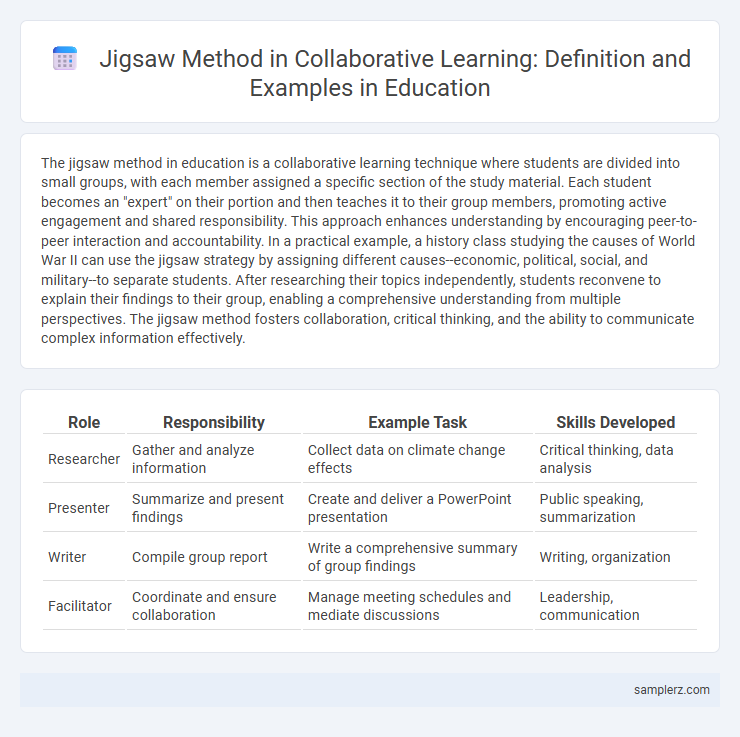The jigsaw method in education is a collaborative learning technique where students are divided into small groups, with each member assigned a specific section of the study material. Each student becomes an "expert" on their portion and then teaches it to their group members, promoting active engagement and shared responsibility. This approach enhances understanding by encouraging peer-to-peer interaction and accountability. In a practical example, a history class studying the causes of World War II can use the jigsaw strategy by assigning different causes--economic, political, social, and military--to separate students. After researching their topics independently, students reconvene to explain their findings to their group, enabling a comprehensive understanding from multiple perspectives. The jigsaw method fosters collaboration, critical thinking, and the ability to communicate complex information effectively.
Table of Comparison
| Role | Responsibility | Example Task | Skills Developed |
|---|---|---|---|
| Researcher | Gather and analyze information | Collect data on climate change effects | Critical thinking, data analysis |
| Presenter | Summarize and present findings | Create and deliver a PowerPoint presentation | Public speaking, summarization |
| Writer | Compile group report | Write a comprehensive summary of group findings | Writing, organization |
| Facilitator | Coordinate and ensure collaboration | Manage meeting schedules and mediate discussions | Leadership, communication |
Understanding the Jigsaw Method in Collaborative Learning
The Jigsaw Method in collaborative learning involves dividing a class into expert groups where each member masters a segment of the material, then rejoining into mixed groups to teach peers their specific topic. This strategy enhances comprehension by promoting active listening, critical thinking, and accountability among students. Research shows that using the Jigsaw Method improves retention and fosters a deeper understanding of complex subjects through peer collaboration.
Key Steps to Implementing Jigsaw in the Classroom
Divide students into diverse expert groups to research specific parts of a topic; each member becomes responsible for mastering and teaching their segment. Reassemble students into mixed jigsaw groups where each expert shares their knowledge, promoting peer teaching and active listening. Facilitate whole-class discussions to integrate all pieces, assess understanding, and encourage collaborative reflection on the topic.
Real-World Classroom Example of Jigsaw Collaboration
In a real-world classroom example of jigsaw collaboration, students are divided into expert groups, each responsible for mastering a specific section of a history chapter on World War II. After thorough research and discussion, members from each expert group rearrange into mixed groups where they teach their area of expertise, ensuring comprehensive understanding for all students. This method fosters active participation, accountability, and enhances knowledge retention through peer-to-peer teaching.
Enhancing Student Engagement with Jigsaw Activities
Jigsaw activities enhance student engagement by dividing classroom content into segments that each group member becomes an expert on, promoting active participation and accountability. This cooperative learning strategy encourages deeper comprehension through peer teaching and discussion, fostering critical thinking and communication skills. Research shows that students involved in jigsaw activities demonstrate improved retention and a stronger connection to the material compared to traditional lecturing methods.
Benefits of Jigsaw for Peer-to-Peer Knowledge Sharing
Jigsaw promotes active engagement by dividing students into expert groups, enhancing their understanding of specific topics and fostering accountability. This collaborative approach improves communication skills and boosts retention as learners teach and learn from peers. Peer-to-peer knowledge sharing through Jigsaw nurtures critical thinking, empathy, and diverse perspectives in educational settings.
Strategies for Effective Jigsaw Group Formation
Effective jigsaw group formation relies on creating diverse teams where each member holds unique expertise critical to the topic, ensuring interdependence and accountability. Strategies include assigning roles based on students' strengths, balancing group members by skill level, and promoting positive intergroup communication to enhance collaboration. Monitoring group dynamics and providing clear objectives further supports successful knowledge sharing within jigsaw activities.
Assessing Student Performance in Jigsaw Collaborations
Assessing student performance in jigsaw collaborations involves evaluating individual accountability and group interdependence through rubrics that measure contribution quality, communication skills, and comprehension of assigned segments. Teachers use peer evaluations and self-assessments to capture collaborative dynamics and ensure balanced participation. Data from formative assessments and observation checklists provide insights into both content mastery and cooperative learning effectiveness.
Overcoming Challenges in Jigsaw Collaborative Learning
In jigsaw collaborative learning, overcoming challenges such as unequal participation and miscommunication requires structured group roles and clear expectations. Each student becomes an expert in a specific segment, ensuring accountability and active engagement within diverse learning groups. Regular teacher facilitation and peer feedback further enhance understanding and mitigate conflicts during the collaborative process.
Technology Integration in Jigsaw Collaborative Tasks
Jigsaw collaborative tasks enhance technology integration by assigning each student a specific segment of digital content to master and subsequently teach to peers, promoting deeper understanding and active participation. Utilizing tools like shared documents, multimedia presentations, and interactive platforms enables seamless knowledge sharing and real-time collaboration. This approach not only fosters critical thinking and communication skills but also supports personalized learning through diverse technological resources.
Jigsaw as a Tool for Building Critical Thinking Skills
Jigsaw, a cooperative learning strategy, actively engages students in dissecting complex topics by assigning each member a unique segment to master and teach. This method promotes critical thinking as learners analyze, synthesize, and evaluate their segment's information before sharing it with peers. Educators using jigsaw report notable improvements in student comprehension, communication skills, and collaborative problem-solving abilities.

example of jigsaw in collaboration Infographic
 samplerz.com
samplerz.com